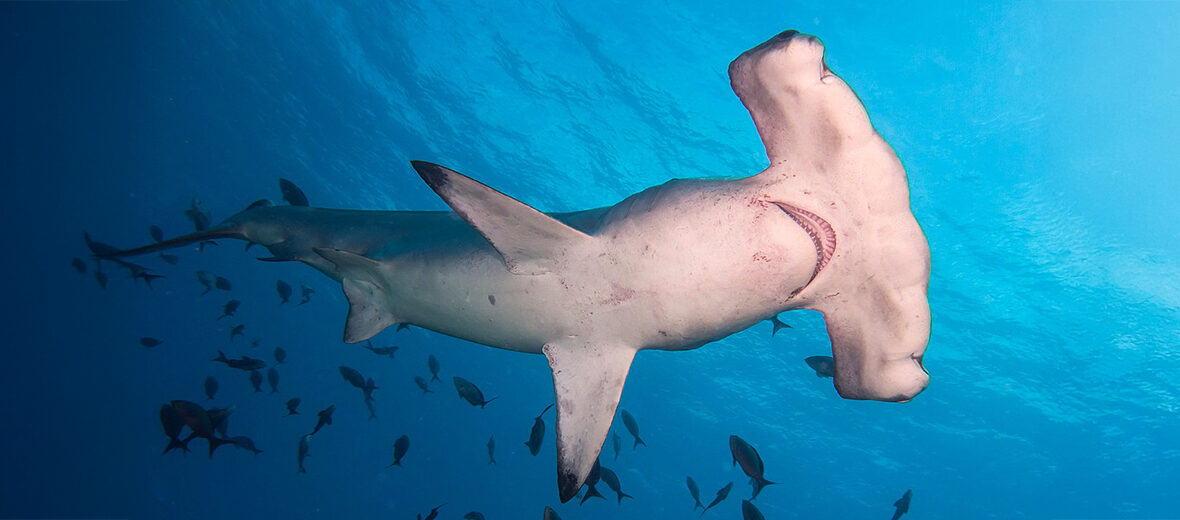
The scalloped hammerhead shark, aka bronze, kinky-headed, or southern hammerhead, dwells in warm, temperate, and tropical coastal waters around the globe. While large in stature, they are smaller than the smooth hammerhead or the great hammerhead. These sharks are extensively caught globally via purse seine, small-scale pelagic longline, and gillnet fisheries. They are both intentionally caught and caught as bycatch. As a result, these sharks are overfished and are thus listed as Critically Endangered by the IUCN. Their numbers also continue to plummet.
First the Stats…
Scientific name: Sphyrna lewini
Weight: Up to 336 lbs.
Length: Up to 14 feet
Lifespan: Up to 30 years
Now on to the Facts!
1.) These hammerheads were first discovered by Edward Griffith and Hamilton Smith in 1834.
2.) They can dive up to 1,600 feet.
3.) These sharks are the most commonly seen hammerhead of the 10 known species.
4.) Sphyrna hails from Greek and translates to hammer.
5.) Scalloped hammerheads have a very large first dorsal fin that is marginally hooked and a smaller 2nd dorsal fin.
But wait, there’s more on the scalloped hammerhead shark!
6.) Due to their high metabolic rate, these sharks need a near constant supply of food. This is especially the case with juveniles. If they don’t find food on a daily basis, they will likely starve.
7.) Juveniles and pups tend to dwell in shallow coastal waters, like bays and mangroves. This affords them with protection from larger predators.
Did you know…?
They are known for their large and complex brain, with amazing levels of cognitive capabilities, sensorimotor functions, social intelligence, intricate migrations, complex habitat relationships, and vigorous capture of their prey.
8.) These sharks are cathemeral, often being seen throughout the day and night, as well as in the morning in large schools, sometimes numbering in the hundreds; most likely because large groups can catch food more easily than singly or small groups can.
9.) Unlike other hammerheads, scallops are not considered to be a danger to humans, as they tend to shy away from contact.
10.) Females birth annually and undergo up to a 12 month gestation (pregnancy) that yields up to 41 pups.
But wait, there’s still more on the scalloped hammerhead shark!
11.) If an area’s a population becomes depleted, they recover through reproduction instead of immigration.
12.) Sardines, mackerel, herring, squid, and octopus are their primary prey. Larger individuals also feed on smaller species of shark such as the blacktip reef shark.
Did you know…?
In portions of the Atlantic Ocean, their populations have declined by over 95% in the past 30 years. Among the multiple reasons for this decline are overfishing and the rise in demand for shark fins.
13.) Scalloped hammerheads were the first species of shark to be protected under the U.S. Endangered Species Act.
14.) These sharks are over harvested for their larger size and fins that have ‘high fin needle content;’ their fins are sold for US $100 – $120 per 2.2 lbs.
15.) According to a January 2021 study in Nature which surveyed 31 species of sharks and rays, the number of these species found in open oceans had dropped by an incredible 71% in just 50 years. Scalloped hammerheads were included in this study.
Now a Short Scalloped Hammerhead Shark Video!
Be sure to share & comment below! Also, check out the Critter Science YouTube channel. Videos added regularly!

Want to suggest a critter for me to write about? Let me know here.
Some source material acquired from: Wikipedia & IUCN
Photo credit: Kris Mikael Krister



